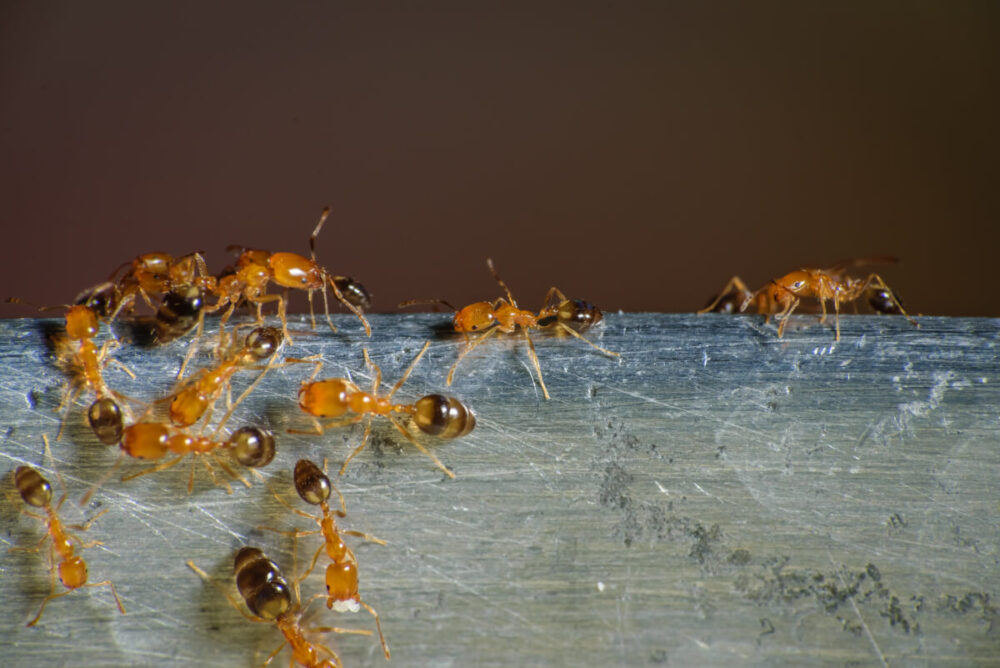


Ants are extremely common across the United States. While many of them are vital to helping your local ecosystem flourish, more than a few ant species have become a nuisance pest for people across the world, with an entire colony spanning buildings and city blocks in search of food and water sources. Given the different types of ants that can pose a pest problem, identifying them is a key step to getting rid of them. For Argentine ants and Pharaoh ants, this rule is no exception.
So what are the differences between Argentine ants and Pharaoh ants? They're visually different and may vary in terms of colony size and feeding habits, especially when the weather permits. However, they do have one thing in common: there's one method that can be extremely effective in removing them from your property.
Learn More: Argentine Ants vs Odorous House Ants
Along with carpenter ants and ghost ants, Argentine ants and Pharaoh ants are prevalent pests that can easily gain entry to buildings in search of edible items. While they're both outdoor species, they can easily nest in buildings and other man-made structures if the active ant infestation has grown beyond a single colony.
Pharaoh ants have a light brown body, though they can also come in shades of yellow to red. They're one of the smaller ant species, though this is more than made up for their aggressiveness and their large colony sizes. Male Pharaoh ants have wings, but they don't fly.
Argentine ants are a little larger and are light to dark brown in color. They tend to form large supercolonies and are extremely aggressive towards other insects and ant species. If the colony is big enough, they can even threaten larger animals like lizards. Only queens have wings, but they don't fly.
Pharaoh ants can nest virtually anywhere they can leave an ant trail to a food source, owing to their small size. You'll most commonly find them in places like wall voids, exterior walls, and other hard-to-reach places, especially in heated buildings. They prefer to nest in warmer areas of the home, but they're also capable of moving their entire colony if needed.
Argentine ants usually like nesting outdoors, in tree stumps, or underneath the earth. However, if the colony is sufficiently big enough, they can also make their homes inside buildings or drive out nearby ant species and take over their nests. Satellite colonies can link up to the main colony, which can result in truly massive Argentine ant infestations.
Pharaoh ants usually depend on one queen to populate the entire colony - female workers may become queens, but they'll usually go somewhere else to raise their own workers and create their own colonies. It takes around 42 days to move from egg to adult, so these colonies can multiply extremely quickly.
Argentine ant colonies don't expand by laying more eggs, but rather through branching out into new colonies. Each colony can have hundreds of queens at a time, which will all move away from the main colony with a handful of workers to establish an ant nest. Their numbers drop during winter but rise sharply after the spring.
Both Argentine and Pharaoh ant colonies can be extremely difficult to remove, primarily due to their large sizes and thousands of workers supporting the nests. They're also highly resilient to most conventional applications of insecticide and pesticide, as most of the colonies - including their queens - are located deep within the nests, which can be difficult to penetrate.
However, there's one specific ant control method that works the best: ant bait. By using their food preference and accounting for the demands of their rapidly growing colonies, homeowners can deal a sizable blow to the colonies, which may be enough to get rid of them for good.
Here's what you need to keep in mind when you're trying to get rid of these ants:
While Argentine ants and Pharaoh ants alike can eat almost anything - including dead insects - they have a particular food preference for sugary foods. If you're looking to use ant baits, avoid greasy bait as much as possible and settle for sweet baits that are more appealing to these ants.
But if sweet baits aren't on hand, you can still use bait near their preferred food sources, making sure to use sugar droplets or other sweet foods to attract them. Because both of these ant colonies can grow quickly and rapidly, making sure that the ants find your bait station immediately is key to your bait working.
Bait stations need upkeep, so expect to keep baiting your ants anywhere from up to a few weeks to a few months. Larger colonies will require refillable bait stations that are replaced regularly as soon as they go empty to ensure as many ants take it as possible. For faster results, you can even put the baits near likely places where these ants nest.
Consistency is one of the keys to successful baiting, as both of these species can forage incredibly far to find a food source. A well-supplied bait station can easily hit thousands to millions of ants as long as it's refilled and can wreak havoc on the colony before they catch on.
Finally, it's important to choose a slow-acting bait, so affected ants can return to the colony and spread it to other ants. Too strong of a formula will kill the ants before the rest of the colony can use your bait as a food source, which can potentially warn away other ants. Slow-acting bait also ensures that your stations affect as many ants as possible before it kills them.
Slow-acting baits also have the potential to reach the queen herself, which can deal a crippling blow to the growth of an ant colony. This is more effective against Pharaoh ants since they usually rely on a single queen for their reproduction, but it can also drastically slow down or stop the growth of Argentine ant colonies as well.
Read More: What To Do If Bitten By Argentine Ants

With the different types of ants that can invade your home, it's important to differentiate the specific ant species so you can apply the right removal methods for them. For Argentine ants and Pharaoh ants, baits are a great way to put a dent in their population - through their ability to rapidly breed and settle in hard-to-reach places means that you may usually end up needing professional help to permanently remove them from the premises.
For times when sweet foods, sweet items, sprays, and baits aren't enough, PermaKill Exterminating can get rid of the ant infestation for you. As an experienced remover of common ant species, we get rid of Argentine ant colonies, Pavement ant nests, carpenter ants, and even odorous house ant infestations. Our treatment plan uses a variety of ant control methods for active and preventative results.
Contact us today to get your estimate for our pest removal services.